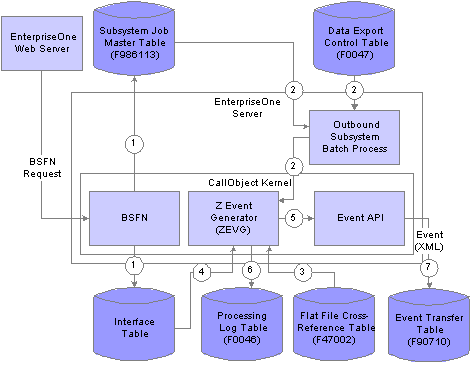Z Event Process Flow
This diagram shows Z event processing. The diagram expands on the system diagram provided in the Using Events - Guaranteed Overview chapter. This diagram details the processing that the CallObject kernel does during Z event processing. In the System Overview diagram, the BSFN uses the Event API, all within the CallObject kernel and in turn places the event data into the F90710 table. For Z events, additional processing occurs within the CallObject kernel before the event is placed into the F90701 table. Z events that are placed in the F90710 table are already in XML format (unlike real-time and XAPI events, which only have raw event data in the table).

In summary:
When a JD Edwards EnterpriseOne transaction occurs, the master business function writes the transaction information in the appropriate interface table and sends an update record to the F986113 table.
A batch process monitors the F986113 table. When the batch process finds a W status in the F986113 table, it notifies the Z Event Generator (ZEVG), which is part of the CallObject kernel. The batch process looks in the F0047 table to determine which Z-event generator to call.
The F47002 table provides a cross-reference between the transaction and the interface table where the record is stored. This information is used by the Z-event generator.
The Z-event generator retrieves the transaction information from the interface table and converts the transaction information into an XML document using a JD Edwards EnterpriseOne DTD.
The Z-event generator sends the event (in the form of an XML document) to the event API for distribution.
After an event is successfully generated, the successfully generated column in the F0046 table is updated. A UBE purges information in the interface table based on information in the F0046 table.
The Event API sends the XML document to the F90710 table, where it is retrieved by the Transaction server and routed to a subscriber.